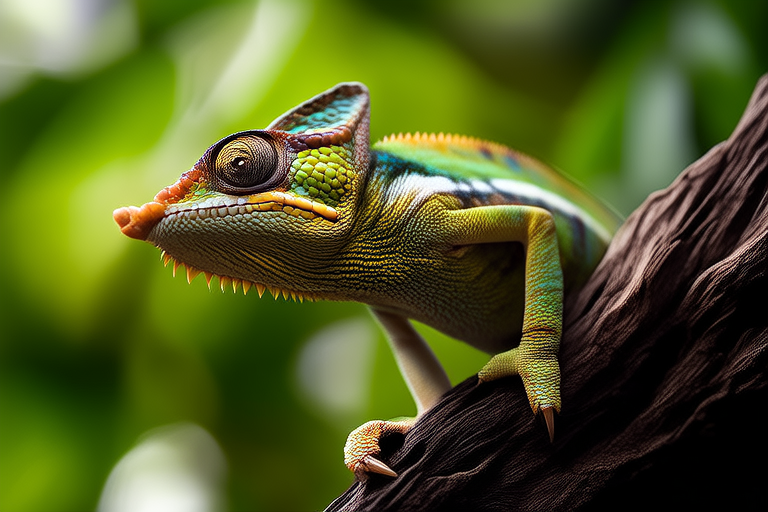Top 10 Fascinating Facts About Chameleons You Never Knew
Chameleons, with their distinctive appearance and remarkable abilities, have long captured the imagination of people worldwide. These captivating reptiles are not only known for their ability to change color but also for a range of fascinating behaviors and adaptations. This article delves into ten lesser-known facts about chameleons that will leave you in awe.
1. The Colorful Conundrum: More Than Just Camouflage
While many assume that chameleons change color solely for camouflage, this isn’t entirely accurate. Their color-changing abilities serve multiple purposes. Chameleons can alter their hues to regulate body temperature, communicate emotions, and express health status. For instance, a male chameleon may display vibrant colors during courtship displays or when defending territory against rivals. Additionally, they can turn darker to absorb heat from the sun or lighter to reflect it and stay cool.
2. Zipping Along: Unique Tongue Mechanics
Chameleons possess one of the most extraordinary hunting mechanisms in the animal kingdom. Their tongues can extend up to twice their body length, enabling them to catch prey from considerable distances. What’s even more astonishing is the speed at which they do this—up to 26 body lengths per second. The tongue is equipped with a sticky tip that adheres to insects, ensuring a successful catch. This lightning-fast action is made possible by a combination of elastic tissues and muscles that store and release energy efficiently.
3. Eyes Like Binoculars
One of the most striking features of chameleons is their independently rotating eyes. Unlike humans, who have binocular vision, chameleons can rotate each eye in different directions simultaneously. This allows them to scan their environment for threats and prey without moving their head. With this incredible ability, they can see nearly 360 degrees around them, providing a significant advantage in both hunting and survival.
4. Tail as a Tool
Chameleons’ tails are not just appendages; they are essential tools for climbing and balance. These prehensile tails can grip branches and other surfaces securely, allowing chameleons to move effortlessly through trees. They can even wrap their tails around branches while sleeping, creating a safe resting spot. Moreover, the tail serves as a fifth limb, helping chameleons navigate challenging terrains with ease.
5. The Silent Hunter
Chameleons are remarkably quiet creatures, which aids them in ambushing prey. They don’t make any vocal sounds, unlike many other reptiles. Instead, they rely on their keen senses and stealthy movements to approach unsuspecting insects. This silent approach increases their chances of success in hunting, making them formidable predators in their natural habitat.
6. Diverse Diet Beyond Insects
Although chameleons are primarily insectivores, some species have been observed eating small birds, lizards, and even smaller chameleons. This dietary flexibility has allowed certain species to adapt to various environments and food sources. For example, the veiled chameleon, native to Yemen and Saudi Arabia, has been known to consume small vertebrates, showcasing the versatility of these reptiles.
7. Longevity in Captivity
In the wild, chameleons typically live between 3 to 5 years, depending on species and environmental factors. However, in captivity, where they are provided with optimal care and conditions, some chameleons can live much longer. With proper nutrition, veterinary care, and suitable living conditions, pet chameleons can reach an age of 7 to 10 years. This extended lifespan in captivity highlights the importance of understanding and meeting their specific needs.
8. Social Signals: Communication Through Color
Chameleons use their color-changing abilities extensively for communication. Different shades and patterns can indicate various emotional states such as stress, fear, excitement, or aggression. Males often display bright colors during mating rituals to attract females or intimidate competitors. Females, too, can change color to signal readiness for mating or rejection of a suitor. Understanding these signals can provide valuable insights into the social dynamics of chameleon populations.
9. Unique Reproductive Strategies
Some chameleon species exhibit unique reproductive strategies. For instance, the Jackson’s chameleon from East Africa is ovoviviparous, meaning the eggs develop inside the mother’s body until they hatch, after which she gives birth to live young. This method provides additional protection for the developing offspring compared to laying eggs exposed to external elements. Other species lay clutches of eggs, with the number varying widely among different species, from a few to over 100 eggs at a time.
10. Adaptation to Arid Environments
Chameleons have evolved several adaptations to thrive in arid environments. One such adaptation is their ability to collect water droplets from the air using their long, forked tongues. They can also slow down their metabolism to conserve energy and water during periods of drought. Additionally, their specialized skin helps them retain moisture, contributing to their survival in harsh desert conditions. These adaptations demonstrate the resilience and ingenuity of chameleons in adapting to diverse habitats.
Chameleons are truly remarkable creatures with a plethora of fascinating traits and behaviors. From their unique color-changing abilities to their exceptional hunting techniques, these reptiles continue to intrigue and inspire. Whether you’re an avid animal enthusiast or simply curious about the natural world, learning about chameleons offers a glimpse into the wonders of evolution and adaptation.
